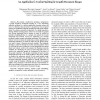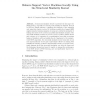165
Voted
PAMI
2012
13 years 3 months ago
2012
—Social media networks contain both content and context-specific information. Most existing methods work with either of the two for the purpose of multimedia mining and retrieva...
151
click to vote
PAMI
2012
13 years 3 months ago
2012
—Many face recognition algorithms use “distance-based” methods: Feature vectors are extracted from each face and distances in feature space are compared to determine matches....
144
Voted
SIGMOD
2012
ACM
13 years 3 months ago
2012
ACM
Cloud enabled systems have become a crucial component to efficiently process and analyze massive amounts of data. One of the key data processing and analysis operations is the Sim...
132
Voted
ICDAR
2011
IEEE
14 years 8 days ago
2011
IEEE
—We present a method for spotting a subgraph in a graph repository. Subgraph spotting is a very interesting research problem for various application domains where the use of a re...
124
click to vote
ICDAR
2011
IEEE
14 years 8 days ago
2011
IEEE
—In this paper, we present a segmentation-free word spotting method that is able to deal with heterogeneous document image collections. We propose a patch-based framework where p...
125
Voted
SIGMOD
2011
ACM
14 years 3 months ago
2011
ACM
Multimedia similarity search has been playing a critical role in many novel applications. Typically, multimedia objects are described by high-dimensional feature vectors (or point...
137
click to vote
SDM
2011
SIAM
14 years 3 months ago
2011
SIAM
Multi-instance (MI) learning is a variant of supervised learning where labeled examples consist of bags (i.e. multi-sets) of feature vectors instead of just a single feature vecto...
171
Voted
PAKDD
2011
ACM
14 years 3 months ago
2011
ACM
A structural similarity kernel is presented in this paper for SVM learning, especially for learning with imbalanced datasets. Kernels in SVM are usually pairwise, comparing the sim...
136
Voted
TASLP
2010
14 years 7 months ago
2010
Music genre classification techniques are typically applied to the data matrix whose columns are the feature vectors extracted from music recordings. In this paper, a feature vecto...
107
Voted
SIGKDD
2010
14 years 7 months ago
2010
Sequence classification has a broad range of applications such as genomic analysis, information retrieval, health informatics, finance, and abnormal detection. Different from the ...






